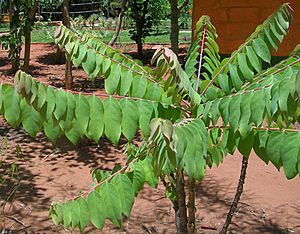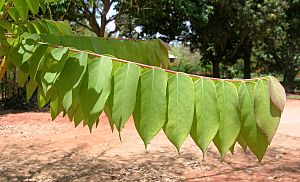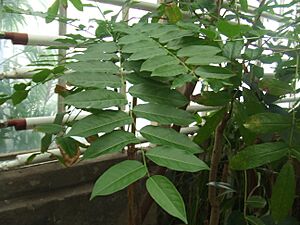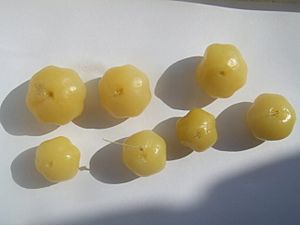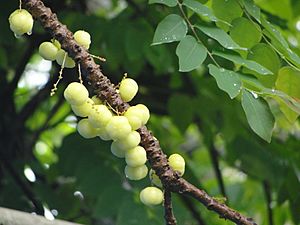Phyllanthus acidus facts for kids
Quick facts for kids Phyllanthus acidus |
|
|---|---|
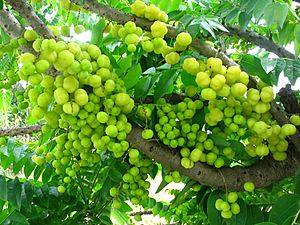 |
|
| Fruits | |
| Scientific classification | |
| Genus: |
Phyllanthus
|
| Species: |
acidus
|
| Synonyms | |
|
Phyllanthus distichus Müll.Arg. |
|
The Phyllanthus acidus, also known as the Otaheite gooseberry or star gooseberry, is a tree that grows small, yellow, edible fruits. It belongs to the plant family Phyllanthaceae. Even though it's called a "gooseberry," it doesn't look like a typical gooseberry plant. However, its fruits are quite sour, just like real gooseberries.
Contents
About the Otaheite Gooseberry Tree
The Otaheite gooseberry is a plant that can be either a large bush or a small tree. It usually grows between 2 and 9 meters (about 6.5 to 30 feet) tall. Its top part, called the crown, is thick and bushy. It has strong main branches with clusters of smaller branches that fall off each year. These smaller branches are green and can be 15 to 30 cm long.
The leaves on these branches are shaped like an oval or a spear, with pointed ends. They are 2–7.5 cm long and thin. The top side of the leaves is smooth and green, while the underside is a blue-green color. This tree looks a lot like the bilimbi tree.
The flowers of the Otaheite gooseberry can be male, female, or have both parts (hermaphrodite). They are small and pinkish. These flowers grow in clusters on long stalks, about 5 to 12.5 cm long. You'll find them on the main branches where there are no leaves, usually higher up on the tree.
The fruits are round and flat, with 6 to 8 ridges, and they grow in tight bunches. They are pale yellow or white, look waxy, and are crunchy and juicy. They taste very sour! Inside each fruit, there's a hard stone that holds 4 to 6 seeds.
Where the Gooseberry Tree Grows
This tropical or subtropical plant is found all over Asia, and also in the Caribbean region, Central, and South America. In Nicaragua, people call it "Grosella."
We're not entirely sure where this plant first came from, but it might have started in Madagascar. It was found in other parts of South Asia a long time ago. For example, it was brought to the Philippines even before recorded history. From there, it spread across the Indian Ocean to places like Réunion and Mauritius. It also crossed the Pacific to Hawaii. In 1793, William Bligh brought the plant from Timor to Jamaica, helping it spread to the Caribbean.
This tree is common in many places, including Guam, Micronesia (where it's called ceremai), South Vietnam (chùm ruột), Laos, northern Peninsular Malaysia (cerme), and India. In India, it has many names like Nellikai (in Kannada), Arunellikai (in Tamil), and Nōṛa (in Bengali). You can also find it in the Philippines (iba or karmay), Cambodia (kantuet), and Thailand (mayom). In Grenada, the fruit is called a damsel. In the United States, it grows in Hawaii and sometimes in parts of Texas and Florida. It's also found in Puerto Rico (grosella), Ecuador, El Salvador, Nicaragua, Mexico, Colombia, Venezuela, Guyana, Suriname, Peru, and Brazil.
Other Names for the Otaheite Gooseberry
This fruit has many different names around the world:
- Arinellikka or Nellikkapuli in Malayalam
- Nallikai in Kannada
- Arainellikai in Tamil
- Narakoḷi in Odisha
- Kantuet in Cambodia
- Nōṛa in West Bengal
- Racha Usiri or Nakshatra Usiri in Telugu
- Orboroi, Noyal, Noyar, Loboni, Hariful in Bengali
- Rayawala in Marathi
- Grosella in Puerto Rico and Belize
- Raspberry in Antigua and Barbuda
- Jimbilin in Jamaica
- Damsel in St Vincent and the Grenadines and Grenada
- Sour Cherry in Trinidad and Tobago
- Karamay in the Northern Philippines
- Layuan in the Bicol region of the Philippines
- Rata Nelli, Nelli Bilin in Sri Lanka
- Bangkiling in the Southern Philippines
- Cermai in Brunei Darussalam, Indonesia, and Malaysia
- Goanbili in Maldives
- ဆီးဖြူသီး in Myanmar
- Guinda in El Salvador
- Azedinha in Cabo Verde
- Groselha in Brazil
- Mayom in Thailand
- Tjerimée in Dutch
- Surette in the French Caribbean
- Poramlakhi in Assamese (India)
- Kawlsunhlu (Burmese gooseberry) in Mizo (India, Myanmar)
How People Grow and Use It
The Otaheite gooseberry tree likes soil that is moist. You can grow it in several ways, not just from seeds. You can also start new plants by using parts of other plants, like cuttings or by a method called air-layering. People grow this tree because it looks nice, but also for its fruit and for traditional medicine.
While the tree produces some fruit all year, the main harvest is usually in January. In South India, however, it produces fruit in April–May and again in August–September. The fruit doesn't get soft when it's ripe, so farmers usually pick it when the fruits start to fall from the tree.
Many parts of the plant are used for food. In Bangladesh, India, and Indonesia, people cook and eat the leaves. The fruit can be eaten fresh, and sometimes it's used to add flavor to other dishes in Indonesia. However, it's usually too sour to eat plain, so it's often prepared in other ways. People make it into candied sweets with sugar, or they pickle it in salt. It's also used to make chutney, relish, or fruit preserves. In the Philippines, it's used to make vinegar, and people also eat it raw after soaking it in salt or a mix of salt and vinegar. They even sell it by the roadside. It's also candied and stored in jars with syrup. In Malaysia, they make a syrup from it. With lots of sugar, it's also used to make fruit juice. In Thailand, it's an ingredient in Som tam and is also pickled or boiled in syrup.
The plant is also used in traditional medicine. For example, leaves mixed with pepper are sometimes used to make a paste that is put on the skin to help with muscle aches. The seeds can be used to help with digestion, and the root, if prepared carefully, can also act as a mild laxative. The fruit syrup is sometimes used to help with stomach issues. In India, people eat the fruit to help their liver. There's also a special preparation called nellikai lekiyam, made with gooseberry fruit, which is given to children to help make them stronger and healthier.
The wood of the Otaheite gooseberry tree is strong, but the tree itself isn't very big, so it's not often cut down for wood. In India, the bark from the root is sometimes used for tanning, which is a process to make leather.
See also
 In Spanish: Grosella estrellada para niños
In Spanish: Grosella estrellada para niños


